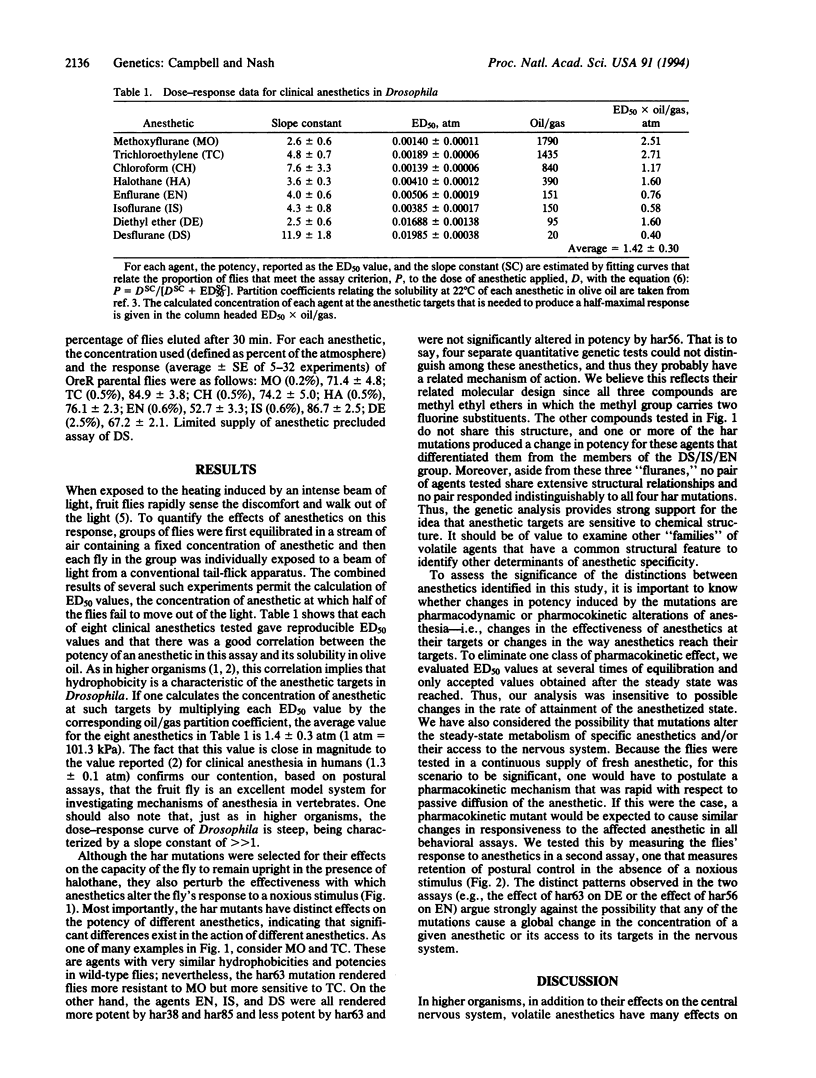Abstract
The way general anesthetics cause their clinically useful effects on the nervous system is not known. Since the principal determinant of the potency of these agents is their solubility in oil, the role of chemical structure in affecting anesthetic targets has been obscured. In this work, we use an intense beam of light (Tinklenberg, J. A., Segal, I. S., Tianzhi, G. & Maze, M. (1991) Ann. N.Y. Acad. Sci. 625, 532-539) to assess the effect of general anesthetics on the capacity of fruit flies to sense a noxious stimulus and respond to it. By examining the effect of halothane-resistant (har) mutations on the potency of various volatile anesthetics in this assay, we establish similarities and differences between these agents that highlight the was chemical structure influences anesthetic action. In general, the potencies of anesthetics with different chemical structure are affected to different extents by one or more har mutations. However, three anesthetics of related structure (enflurane, isoflurane, and desflurane) show quantitatively indistinguishable alterations in potency in each of four genetic tests. These results not only identify important structural features of anesthetics but also place limits on the classical view that all anesthetics act at a common target.
Full text
PDF




Images in this article
Selected References
These references are in PubMed. This may not be the complete list of references from this article.
- Allada R., Nash H. A. Drosophila melanogaster as a model for study of general anesthesia: the quantitative response to clinical anesthetics and alkanes. Anesth Analg. 1993 Jul;77(1):19–26. doi: 10.1213/00000539-199307000-00005. [DOI] [PubMed] [Google Scholar]
- Corbett A. H., Hong D., Osheroff N. Exploiting mechanistic differences between drug classes to define functional drug interaction domains on topoisomerase II. Evidence that several diverse DNA cleavage-enhancing agents share a common site of action on the enzyme. J Biol Chem. 1993 Jul 5;268(19):14394–14398. [PubMed] [Google Scholar]
- Gamo S., Ogaki M., Nakashima-Tanaka E. Strain differences in minimum anesthetic concentrations in Drosophila melanogaster. Anesthesiology. 1981 Apr;54(4):289–293. doi: 10.1097/00000542-198104000-00006. [DOI] [PubMed] [Google Scholar]
- Huff A. C., Kreuzer K. N. Evidence for a common mechanism of action for antitumor and antibacterial agents that inhibit type II DNA topoisomerases. J Biol Chem. 1990 Nov 25;265(33):20496–20505. [PubMed] [Google Scholar]
- Koblin D. D., Deady J. E. Anaesthetic requirement in mice selectively bred for differences in ethanol sensitivity. Br J Anaesth. 1981 Jan;53(1):5–10. doi: 10.1093/bja/53.1.5. [DOI] [PubMed] [Google Scholar]
- Koblin D. D., Deady J. E., Eger E. I., 2nd Potencies of inhaled anesthetics and alcohol in mice selectively bred for resistance and susceptibility to nitrous oxide anesthesia. Anesthesiology. 1982 Jan;56(1):18–24. doi: 10.1097/00000542-198201000-00005. [DOI] [PubMed] [Google Scholar]
- Krishnan K. S., Nash H. A. A genetic study of the anesthetic response: mutants of Drosophila melanogaster altered in sensitivity to halothane. Proc Natl Acad Sci U S A. 1990 Nov;87(21):8632–8636. doi: 10.1073/pnas.87.21.8632. [DOI] [PMC free article] [PubMed] [Google Scholar]
- McCrae A. F., Gallaher E. J., Winter P. M., Firestone L. L. Volatile anesthetic requirements differ in mice selectively bred for sensitivity or resistance to diazepam: implications for the site of anesthesia. Anesth Analg. 1993 Jun;76(6):1313–1317. doi: 10.1213/00000539-199376060-00022. [DOI] [PubMed] [Google Scholar]
- Morgan P. G., Sedensky M. M., Meneely P. M., Cascorbi H. F. The effect of two genes on anesthetic response in the nematode Caenorhabditis elegans. Anesthesiology. 1988 Aug;69(2):246–251. doi: 10.1097/00000542-198808000-00015. [DOI] [PubMed] [Google Scholar]
- Morgan P. G., Sedensky M., Meneely P. M. Multiple sites of action of volatile anesthetics in Caenorhabditis elegans. Proc Natl Acad Sci U S A. 1990 Apr;87(8):2965–2969. doi: 10.1073/pnas.87.8.2965. [DOI] [PMC free article] [PubMed] [Google Scholar]
- Nash H. A., Campbell D. B., Krishnan K. S. New mutants of Drosophila that are resistant to the anesthetic effects of halothane. Ann N Y Acad Sci. 1991;625:540–544. doi: 10.1111/j.1749-6632.1991.tb33885.x. [DOI] [PubMed] [Google Scholar]
- Tinklenberg J. A., Segal I. S., Guo T. Z., Maze M. Analysis of anesthetic action on the potassium channels of the Shaker mutant of Drosophila. Ann N Y Acad Sci. 1991;625:532–539. doi: 10.1111/j.1749-6632.1991.tb33884.x. [DOI] [PubMed] [Google Scholar]
- Waud D. R. On biological assays involving quantal responses. J Pharmacol Exp Ther. 1972 Dec;183(3):577–607. [PubMed] [Google Scholar]




